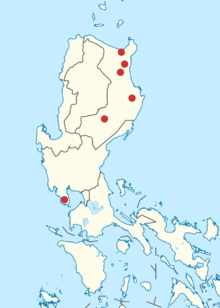Isabela oriole
The Isabela oriole (Oriolus isabellae) is a species of the oriole family endemic to Luzon in the Philippines. The bird was presumed to be extinct for many years until its rediscovery in December 1993 near Diffun, Quirino,[2] and in Mansarong, Baggao, Cagayan in September 1994.[3] Additional sightings were made in 2004 near San Mariano, Isabela.[4]
| Isabela oriole | |
|---|---|
| Scientific classification | |
| Kingdom: | Animalia |
| Phylum: | Chordata |
| Class: | Aves |
| Order: | Passeriformes |
| Family: | Oriolidae |
| Genus: | Oriolus |
| Species: | O. isabellae |
| Binomial name | |
| Oriolus isabellae Ogilvie-Grant, 1894 | |
 | |
| Known locations of sightings or collections | |
Taxonomy and systematics
The Isabela oriole is most closely related to the white-lored oriole. Both species are closely related to the paraphyletic Philippine oriole.[5] The Isabela oriole is sometimes considered to form a superspecies with the dark-throated oriole and the Philippine oriole.[6] Alternate names for the Isabela oriole include the green-lored oriole and olive-lored oriole.
Distribution and habitat
The Isabela oriole is found in the mountains of northern Luzon.[7] It has not been recorded in Bataan province since 1947.[8]
Status
The Isabela oriole has a known population of about fifty individuals and is assessed as Critically Endangered based on its extremely small and fragmented population.[8]
References
- BirdLife International (2017). "Oriolus isabellae". IUCN Red List of Threatened Species. 2017: e.T22706378A118602087. doi:10.2305/IUCN.UK.2017-3.RLTS.T22706378A118602087.en.
- Gamauf, Anita; Tebbich, Sabine (February 1996). "Re-discovery of the Isabela Oriole, Oriolus isabellae" (PDF). Forktail. 11: 170–171. ISSN 0950-1746.
- van der Linde, K. (1996). "A further record of the Isabela Oriole (Oriolus isabellae) from Baggao, Cagayan Province, northern Philippines." Forktail 11: 171.
- van Weerd, M. and Hutchinson, R. (2004) "Observations of Isabela Oriole Oriolus isabellae in the Sierra Madre, Luzon, Philippines, with descriptions of the call." Forktail 20: 133-136. Archived 2012-04-14 at the Wayback Machine
- Knud A. Jønsson, Rauri C. K. Bowie, Robert G. Moyle, Martin Irestedt, Les Christidis, Janette A. Norman, Jon Fjeldså (2010) Phylogeny and biogeography of Oriolidae (Aves: Passeriformes) Ecography 33(2): 232–241 doi:10.1111/j.1600-0587.2010.06167.x
- "Dark-throated Oriole (Oriolus xanthonotus)". www.hbw.com. Retrieved 2017-02-24.
- "Oriolus isabellae - Avibase". avibase.bsc-eoc.org. Retrieved 2017-02-25.
- "Oriolus isabellae (Isabela Oriole, Isabella Oriole)". IUCN Red List of Threatened Species. Retrieved 2017-02-25.
